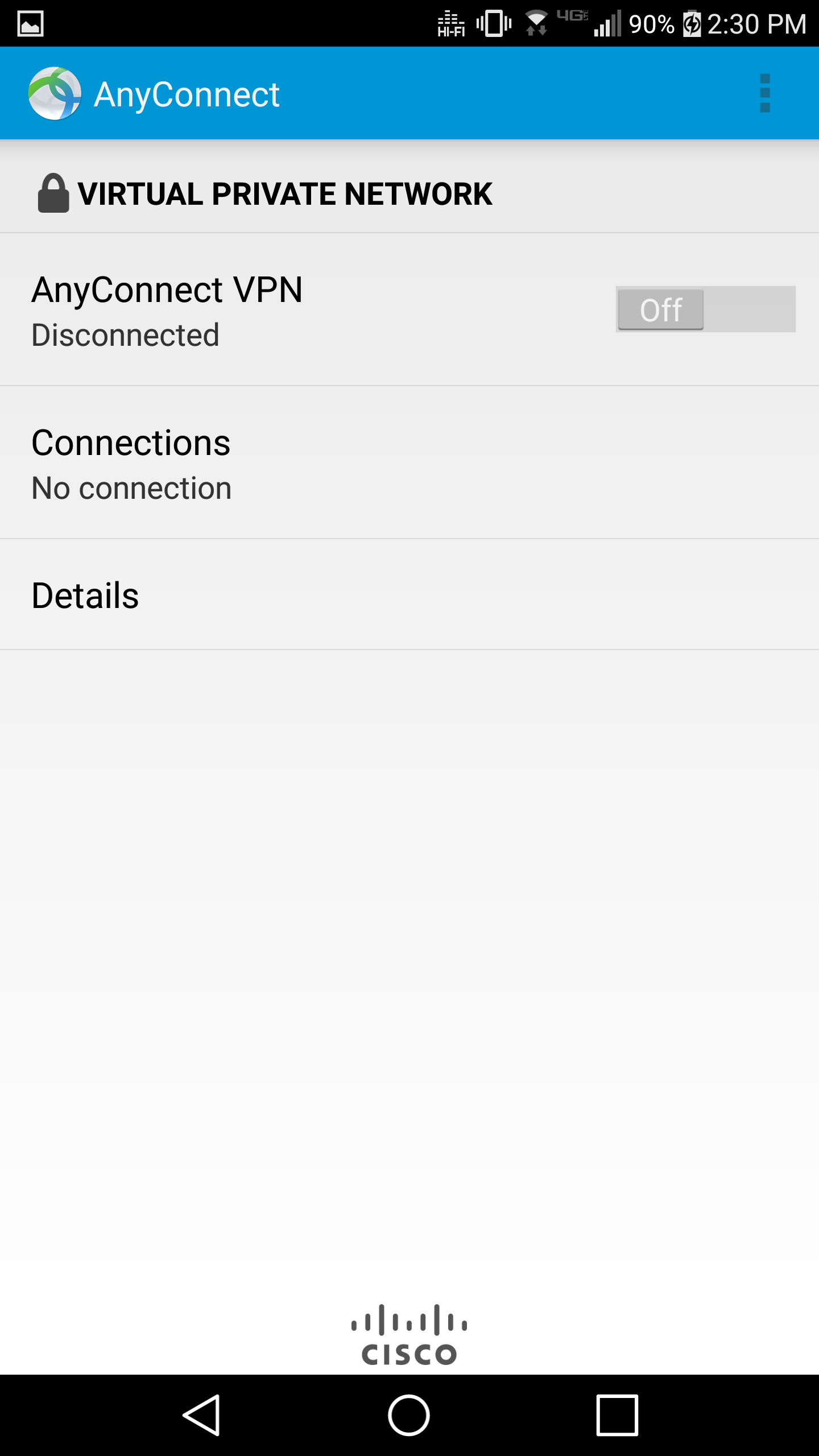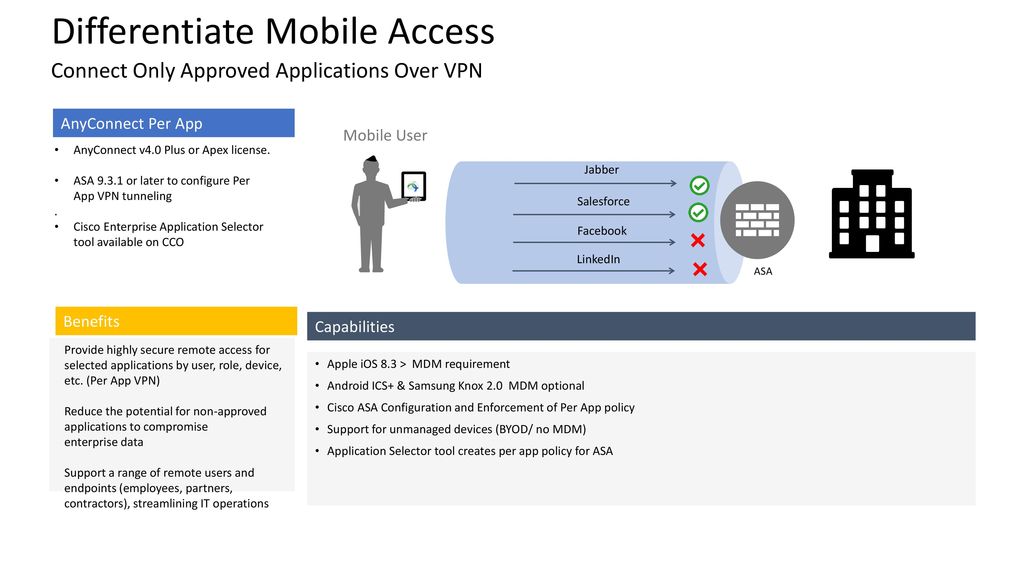Mar 30, 2021 Cisco AnyConnect is available as a mobile app for iOS and Android devices. The program is free to download, and the same user profile will log you in on multiple devices. What are the alternatives? While Cisco AnyConnect is an excellent choice, it can be quite overwhelming for beginners. As such, you might want to consider a few alternatives. When Anyconnect detects always-on VPN in the profile, it protects the endpoint by deleting all other Anyconnect profiles, and ignores any public proxies configured to connect to the ASA This feature requires an Anyconnect Premium License.
- Cisco Anyconnect Mobile Vpn Client Download
- Anyconnect Mobile Client
- Anyconnect Mobile Client Download
Topics Map > Networking > Virtual Private Networking (VPN)
This page contains links to download and installation instructions for VPN software for Windows Vista, Windows 7, Windows 8, Windows 10.
University of Illinois students, faculty, and staff can use these directions to set up their Windows computers or devices to connect to the Virtual Private Network (VPN).
If you have a guest account, Technology Services recommends VPN, Virtual Private Networking (VPN) for Mobile for on-campus use. Contact your host for help downloading and installing the VPN if you need guest access for off-campus use.
Quick Start
- Download the Windows VPN installation package from WebStore.
- Make sure you get the correct version for your processor. Most people need the x86 version, but if your computer or tablet has an ARM processor, download the version for the ARM processor.
- Windows may suggest you configure the built-in VPN instead. This will not work, install the AnyConnect VPN software.
- Install the software with administrator privileges.
- VPN server: vpn.illinois.edu (vpn.cites.illinois.edu will still work, but we encourage everyone doing a new setup to use vpn.illinois.edu)
- Username: Your NetID
(or, if you're a guest, your guest ID) - Password: Your Active Directory password
(or, if you're a guest, your guest password) - Group: 1_SplitTunnel_Default
(Note: This is the most common choice. See VPN, CISCO AnyConnect, About VPN Profiles for information about the alternatives, such as .)
Detailed instructions are provided below.
Installing the VPN software
Cisco Anyconnect Mobile Vpn Client Download
- Go to the location where you saved the VPN installation package.
- Double-click on the .msi fileto open the installer.
- You may receive the User Account Control prompt asking if you want to allow the following program to make changes to this computer. If so, click Yes.
- The Setup Wizard will launch. Click Next.
- Accept the End User License Agreement (EULA) when prompted.
- Several windows will show the progress of the installation.
- When all of the installation procedures are complete, you'll be prompted to reboot your computer.
- After rebooting, your installation is complete.
Starting the VPN Software
On Windows 7 and Vista: Your Programs menu will contain a new Cisco folder. Inside that folder is another folder called Cisco AnyConnect Mobility Client, and inside that folder is a Cisco AnyConnect Mobility icon.
The 'hidden icons' menu in the taskbar will also contain a new Cisco icon.
On Windows 8: To find the Cisco AnyConnect software in Windows 8, use the search tool in the Apps feature to search for 'Cisco'. The 'hidden icons' menu in the taskbar will also contain a new Cisco icon.
Logging in
After you launch the Cisco AnyConnect client:

First, you'll identify the VPN server and start to connect.
- In the Ready to Connect box, enter vpn.illinois.edu.
- Click Connect.
Next, you'll need to enter three pieces of information.
- Username: Your NetID
(or, if you're a guest, your guest ID) - Password: Your Active Directory password
(or, if you're a guest, your guest password) - Group: 1_SplitTunnel_Default
(Note: This is the most common choice. See About VPN Profiles for information about the alternatives).
Note: If you want to access Library resources without logging in to the Library Gateway, you should change to the Tunnel All profile.
When the VPN connects, a blue window will appear toward the lower right side of your screen.
Disconnecting
When you're done using the VPN connection, disconnect it.
- Click on the Hidden Icon menu (shown as an upward pointing arrow near your system clock).
- Click the Cisco AnyConnect icon.
- In the window that appears, click the Disconnect button.
Troubleshooting and the Advanced window
If you encounter problems using the VPN, contact the Technology Services Help Desk.
The Cisco AnyConnect VPN client gathers information that can help you with troubleshooting speed or connectivity issues. It may be helpful to open the Advanced window while troubleshooting with the Help Desk.
To open the Advanced window:
- Click the gear icon toward the lower left corner of the VPN window.
- Choose among the tabs as directed to help your Help Desk consultant with troubleshooting.
As part of its ongoing cybersecurity strategy, The Division of Information Technology has implemented a mandatory two-factor authentication for the Enterprise Virtual Private Network (VPN)
What is two-factor authentication?To increase security measures on your account, two-factor authentication requires two steps to log in. The first step is using something you know (i.e., your password), and the second step is something you have (i.e., cell phone) to securely verify your identity.
What is required to use the VPN?- Enroll your phone for two-factor
- Cisco AnyConnect client
AnyConnect
FIU implements the AnyConnect VPN client to allow FIU users to connect on and off campus to the FIU network through a Secure Socket Layer (SSL) protocol.
- Supported Operating Systems
- System Requirements
- AnyConnect Clients
- Installing the AnyConnect
Supported Operating Systems
Microsoft Windows
- Windows 10 (32-bit and 64-bit)
- Windows 8, 8.1 (32-bit and 64-bit)
- Windows 7 (32-bit and 64-bit)
MAC OS X
- Mac OS X 10.11, 10.12, 10.13, 10.14 x86 (32-bit) or x64 (64-bit)
- Mac OS X versions 10.10 and lower are no longer supported
Linux
- Linux
- Red Hat Enterprise Linux 6.x and 7.x (64-bit)
- Ubuntu 14.04 (LTS), 16.04 (LTS), and 18.04 (LTS) (64-bit only)
System Requirements
Microsoft Windows
- Pentium class processor or greater.
- 100 MB hard disk space.
- Microsoft Installer, version 3.1.
MAC OS X
- 50MB of hard disk space.
- To operate correctly with Mac OS X, AnyConnect requires a minimum display resolution of 1024 by 640 pixels.
Linux
- x86 instruction set.
- 32-bit or 64-bit processor.
- 32 MB RAM.
- 20 MB hard disk space.
- Superuser privileges are required for installation.
- libstdc++ users must have libstdc++.so.6(GLIBCXX_3.4) or higher, but below version 4.
AnyConnect Clients
MAC OS X
- Intel download 4.9.X
AnyConnect Secure Mobility Client for Android Devices

All Android AnyConnect packages are available for installation and upgrade from the Google Play Store
For additional information regarding supported Android devices, please visit Cisco's support documentation
AnyConnect Secure Mobility Client for Apple Devices
All Apple AnyConnect packages are available for installation and upgrade from the Apple App Store

For additional information regarding supported Apple devices, please visit Cisco's support documentation
TwoFactor
Enroll
In order to verify your identity, you will be required to enroll your phone (“something you have”) in FIU’s two-factor authentication system.
Please review these simple step-by-step instructions below to enroll your phone:
- Visit login.fiu.edu/enroll
- Log in using your FIU username and password
- When prompted, enter the phone number of the device you would like to enroll in two-factor authentication (FIU numbers will not be accepted).
- Specify what type of device corresponds to the enrolled number
- When prompted, enter the code you received
- You are now enrolled in two-factor authentication
TwoFactor with VPN

Original doom download mac. Launch your Cisco AnyConnect VPN client, you will be prompted for your FIU username, password, and a “second password”. In this second password field, you will specify your preferred verification method (“something you have”).
In the second password field, you will be required to type “push”, “phone”, or “sms”.
- Push: uses the DUO Mobile app *
- Phone: places an automated voice call *
- SMS: sends unique verification codes via text messages **
(*Note: Your carrier’s data and message rates may apply)
(**Note: Your carrier’s data and message rates may apply, 10 codes are sent in one text message to use 10 different times.)
Signing into Any Connect VPN using Two-FactorAnyconnect Mobile Client
FAQs
SSL VPN is a client application used to connect to the VPN. This is an application, which gets installed on the computer. This client has support for 64bit systems. This is also known as the AnyConnect client.
Use your My Accounts username and password to access the FIU VPN.Visit https://myaccounts.fiu.edu for additional information.
AnyConnect client.
Anyconnect Mobile Client Download
Yes. Please look above for supported devices.
